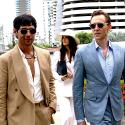Feelings. Whoa whoa whoa feeeelings. Just like that Morris Albert hit of the Seventies for star-crossed lovers everywhere, I lost count of the number of times I heard that word in this Alan Yentob meets Jeff Koons love-in. Or, more precisely, “feeling” singular, since Koons, one of the most bankable artists in the world, was talking about the “feeeeling” aroused when you looked at one of his art works.
The engendered feeling was, we learned, a cross between sex-lust, consumer-lust and religious transcendence – “transcendence” being another favoured Koons word. And left to his own words, Koons was a marvel. Here he was telling Yentob about one of his favourite appropriated cartoon motifs:
“Popeye is very, very similar to these medieval sculptures. You have a sense of transcendence taking place here… transcendence of male energy. When he eats the spinach he transcends into that strength. And, you know, that’s the art – the spinach is art.”
Among all this talk of advertising, consumer desire and seduction, something was missing
Transcendent spinach. I’m with you, Jeff. But Koons, who’s now 60, must have discovered all this stirring stuff about feeling and transcendence late in his career, because we also saw early clips where he tells us how his work was actually all about “emptiness”. “I always like the idea of vacuum art,” said the shiny, preppy Koons of the Eighties when he’s talking to a sceptical English critic about his vacuum cleaner series and how he likes it that they’re a kind of metaphor for “the emptiness of art”. But Koons doesn’t use the word “metaphor”. It just doesn’t appear to exist in the Koons lexicon, and I suppose when you’re telling the world about feeling and transcendence, and even emptiness – well, what has something as artful as metaphor to do with the immediacy of all that feeling? Whoa whoa whoa.
And just as interesting as the stuff that came out of Koons’ mouth, was his face. I couldn’t tear my eyes off that face. Did I really imagine the passing shadow of anxiety in those eyes before he arranged his face into the mask of the ultimate smile and shoeshine salesman? No, I really don’t think I did. But then he opened his mouth again, and I found I could listen to Koons talking about vacuum cleaners all day. “See the words ‘Wet Dry’ on the side of the Hoover?” he asked. “That’s like Kierkegaarde’s ‘Either Or’,” he explained. See what I mean?
But then there were the other talking heads: those in the For Koons camp, those in the Anti-Koons camp, and just one who, for the sake of critical detachment, appeared to position himself somewhere in the middle, neither embracing nor condemning.
Former Royal Academy secretary Norman Rosenthal, definitely in the first camp, popped up but said nothing. Really, nothing. He was like the living embodiment of Koonsian emptiness – a man made up of superlatives but no critical acumen. Then there was neuroscientist Eric Kandel, another Koons fan, who talked about “incorporating the beholder into a work of art”. Kandel was seduced by the idea of Koons’ use of mirror surfaces. “You actually visualise yourself,” enthused the 85-year-old Nobel laureate. “I’ve never seen that before and I’ve looked at art for much of my life.” Clearly he’d never seen, say, the mirror paintings of the Italian Michelangelo Pistoletto from the early Sixties, but, hey, that’s just European art. With few exceptions that probably doesn’t count for an American.
The best talking head was the American critic and man-in-the-middle Hal Foster, who said that Koons, like Warhol, affected the persona of “liking” everything. So maybe “feeling” and “transcendence” – once Koons had got over the “emptiness” of the readymade and graduated to the perfectly crafted, immaculately finished hyper-kitsch object – was really just like repeating Warhol’s infantilised utterance of wonder, “Gee”.
Foster also told us that Koons “wants to embody that postwar American being made by consumer culture”. This seemed both a clear-eyed and an obvious thing to say, but it left one ringing question. Among all this talk of advertising, consumer desire and seduction, something was missing. Doesn’t Koons' work also engender a feeling of repulsion? All that hyper-kitsch stuff that makes the viewer positively recoil. Advertising doesn’t do that, even old advertising that ends up looking dated or ridiculous. Much of pop culture doesn’t seek to do that, either. But art does and can. Art can be both seductive and repulsive, dumb and clever, base and transcendent. That constant push-pull is what gives it traction as art.
This Imagine was, as it turned out, unexpectedly fascinating – I mean, Koons himself is both seductive and repulsive, dumb and clever. He embodies his own art (though I'm not sure I'd go as far as saying he, or his work, are base and transcendent). But the programme didn’t really go over any of that. So it was, in the end, a bit thin, a bit empty.














Add comment